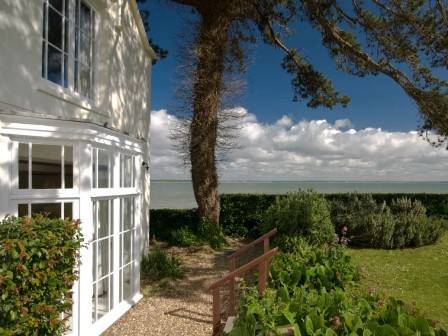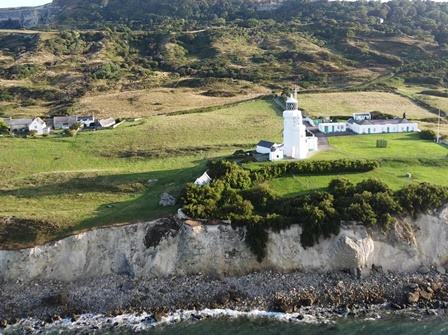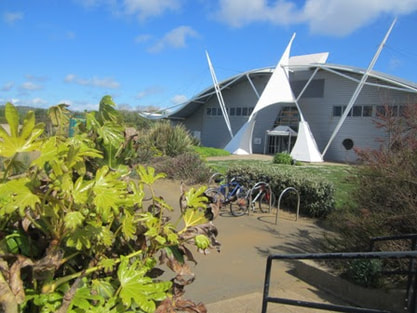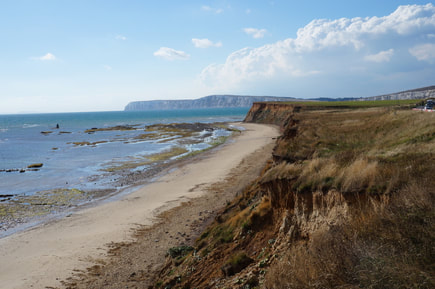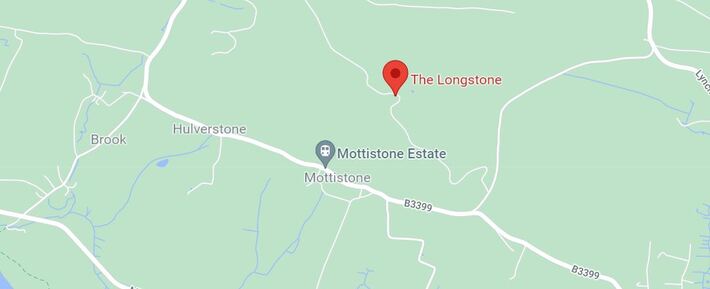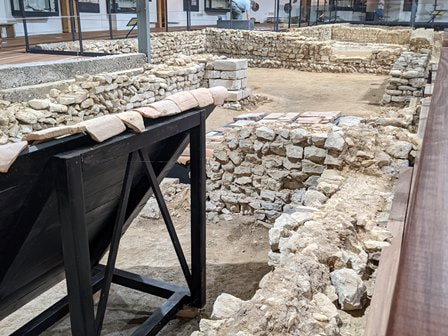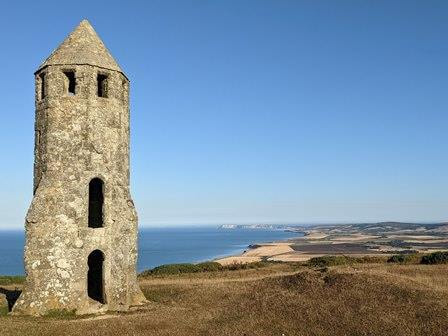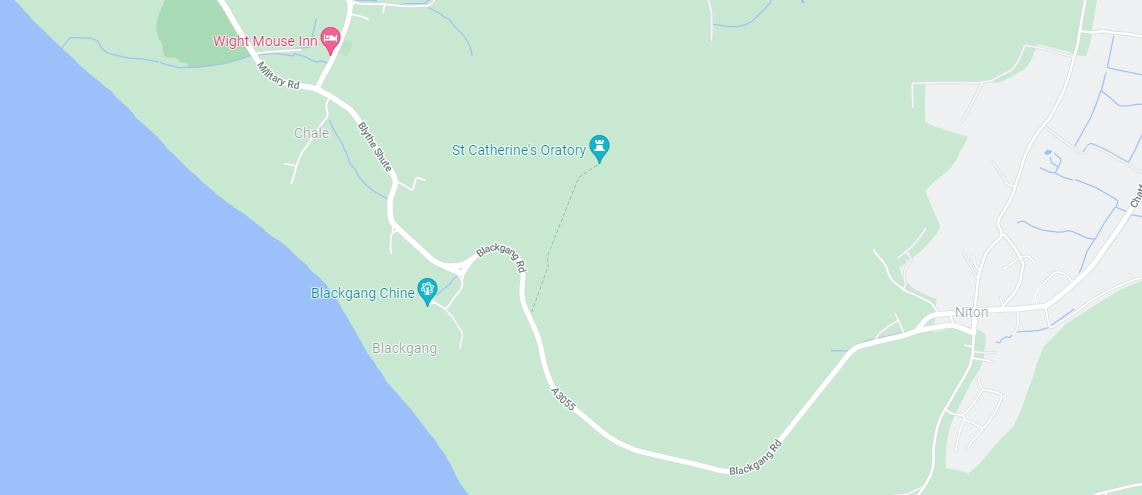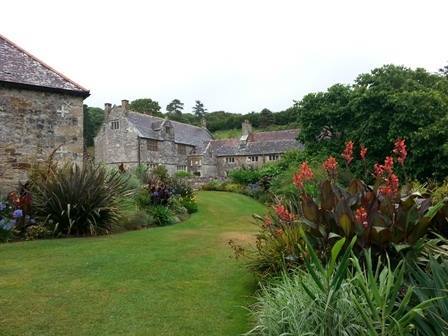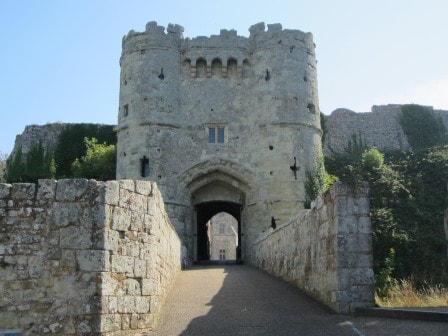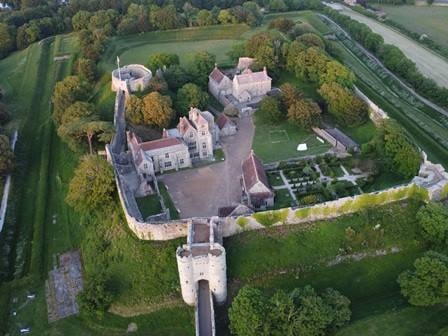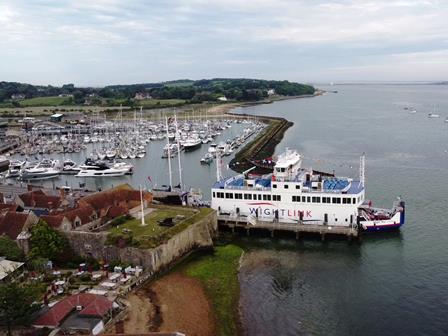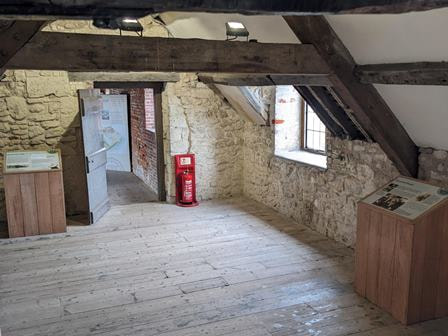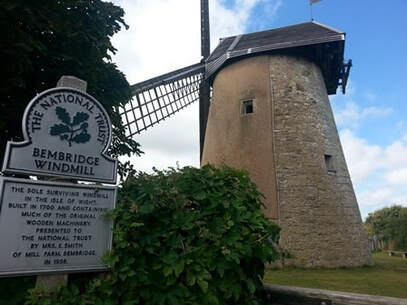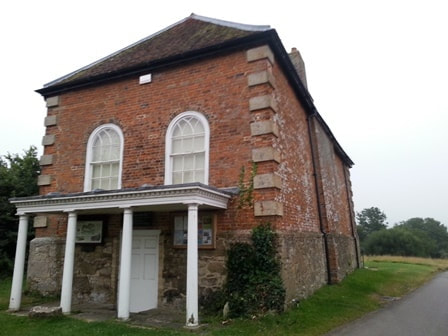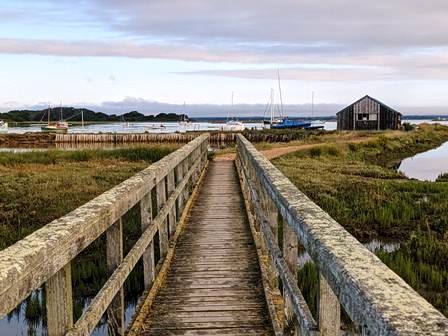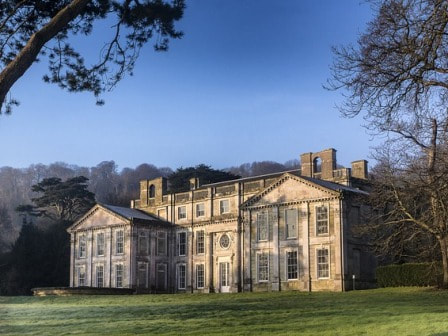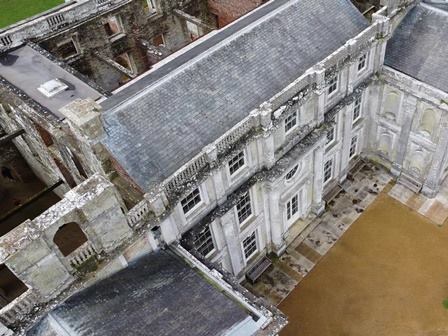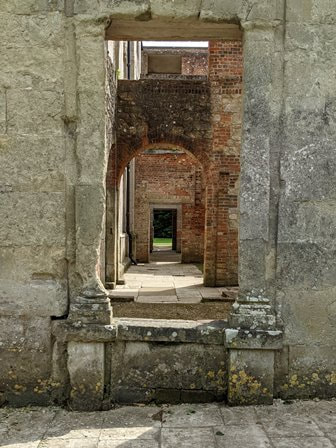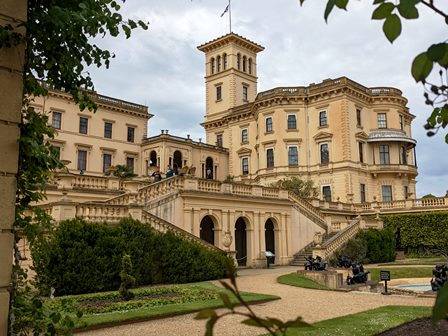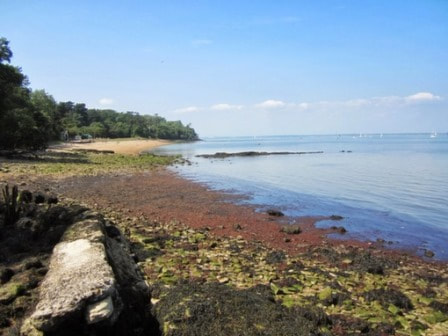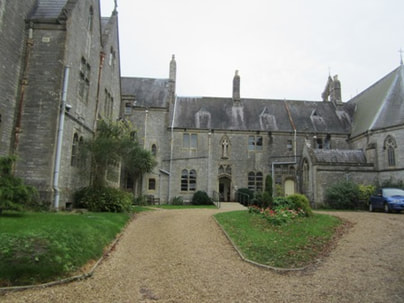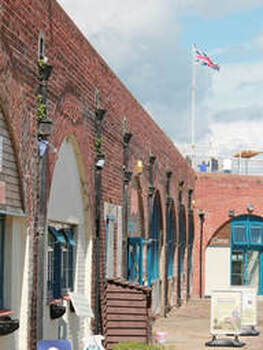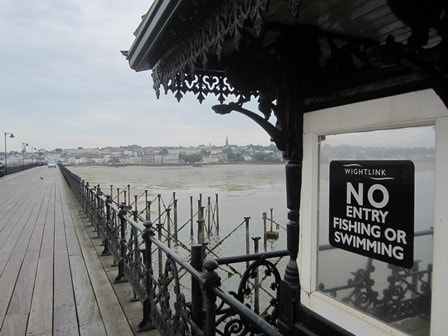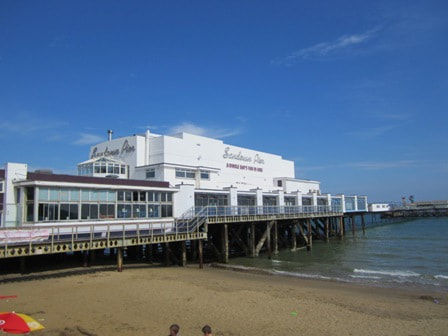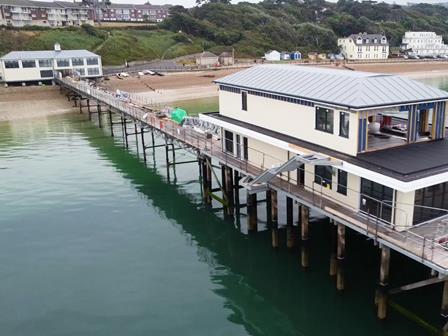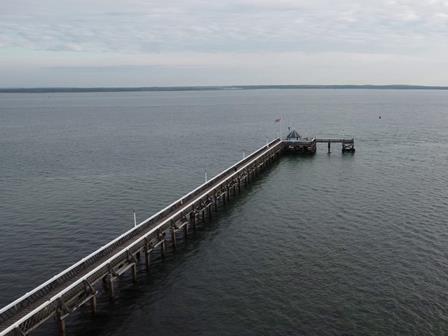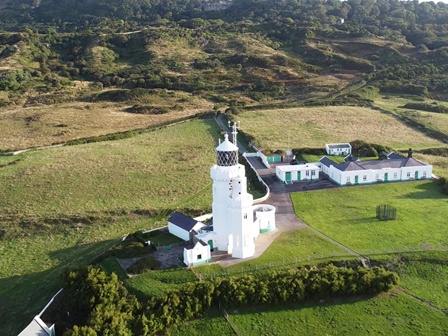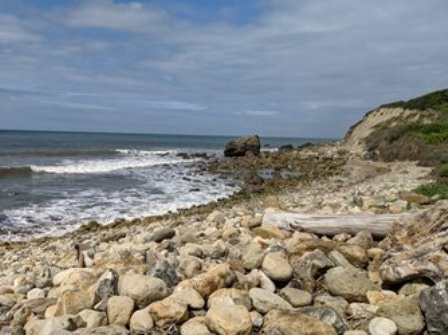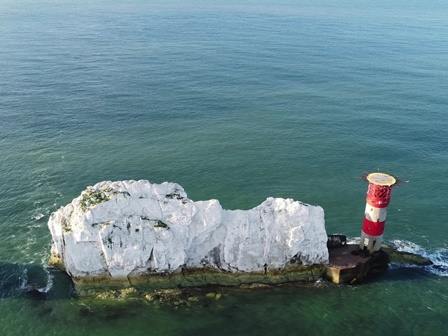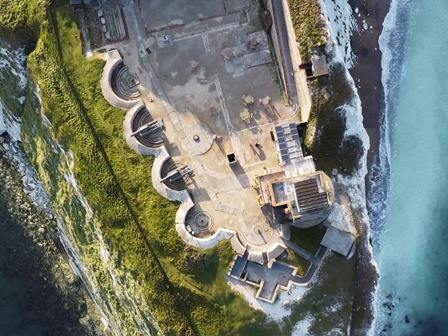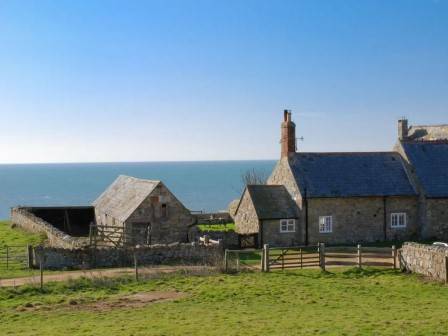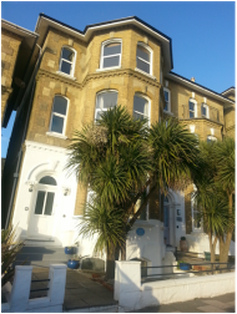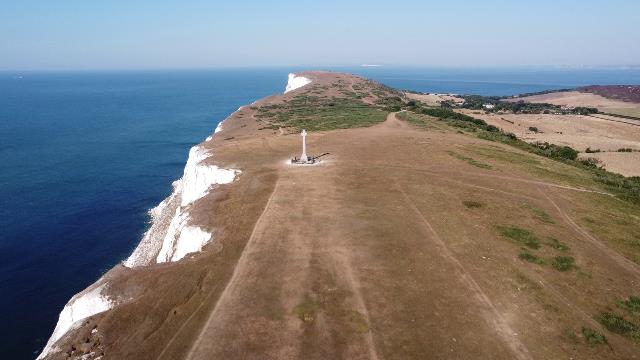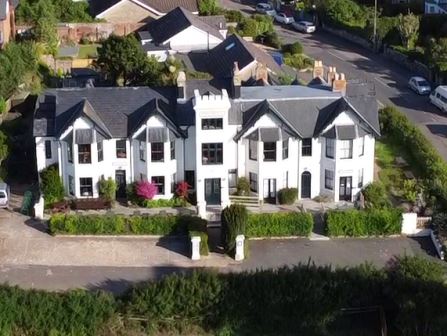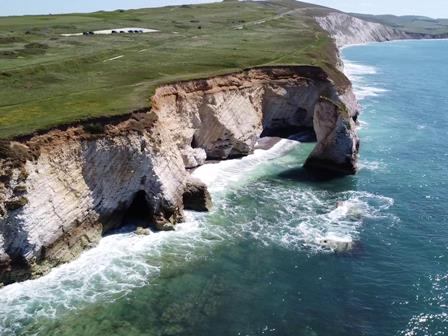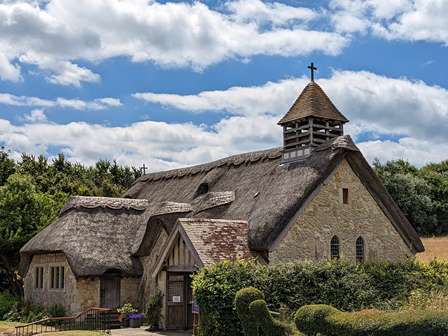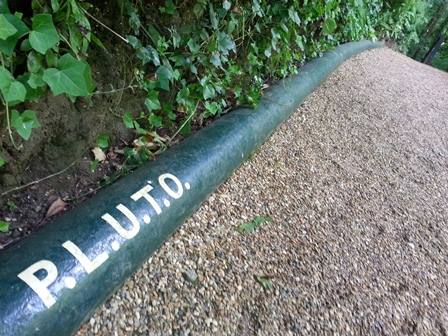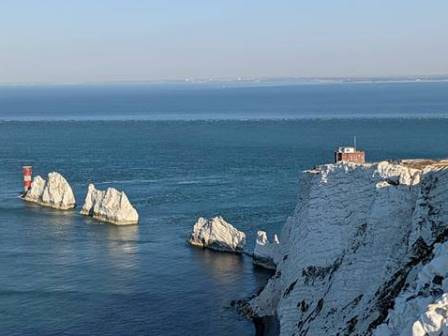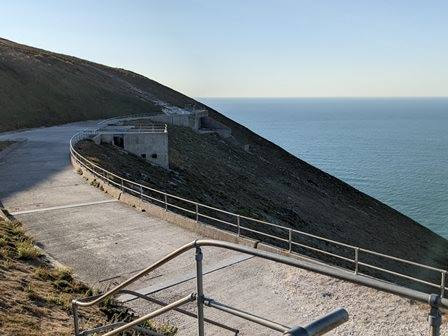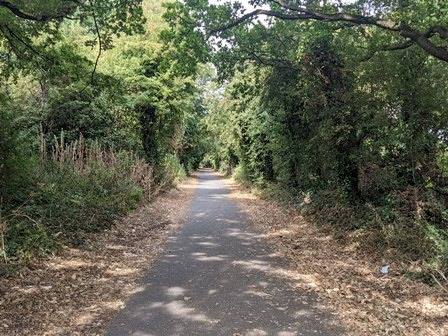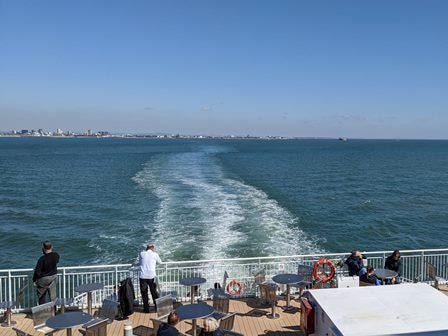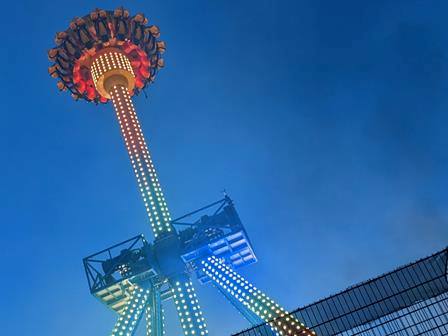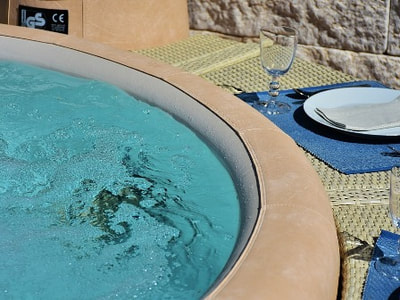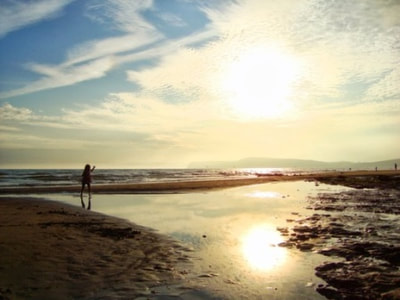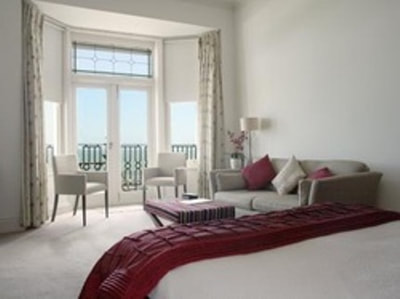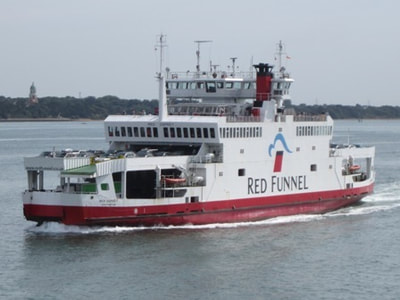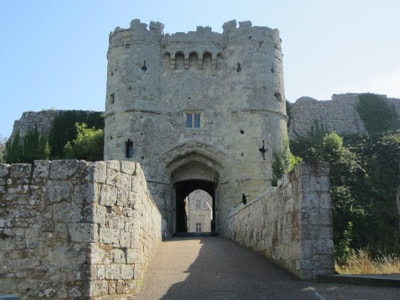This site uses cookies - see our privacy policy. Ads & links in bold may give us a small payment from the seller, at no cost to the buyer. However, this never affects our views - if we like it, we recommend it.
29 Historic Days Out And Attractions On The Isle Of Wight (2024 Guide)
The Isle of Wight is bursting with castles, royal residences, ancient churches, windmills, piers, dinosaur bones and modern-day sites such as the 1970 Isle of Wight pop festival site. Here's our guide to 25 historic days out on the Isle of Wight.
Historic places to stay
You might like to incorporate some history into your choice of accommodation. Our guide to 20 quirky places to stay includes historic sites such as:
- Lighthouse keepers' cottages at St Catherine's Lighthouse (sleeps 4-5) or former coastguard cottages at The Needles (sleeps 4-14).
- An eight-sided sea defence called Golden Hill Fort (sleeps 6-7)
- The cottage where Winston Churchill's parents met (sleeps 6-10).
- The coastal cottage where Marconi carried out early experiments (sleeps 4)
- Historic manor houses such as Shanklin Manor (sleeps 4).
- A World War 2 radar station on St Boniface Down (sleeps 8)
Prehistoric sites on the Isle of Wight
1. Dinosaur Isle
Dinosaur Isle opened in 2001 as Britain’s first purpose built dinosaur museum. It’s got a range of fossils, some of which are thought to be about 126 million years ago (don’t ask me to explain why it is 126 as opposed to 125).
See our guide on getting discounts to Isle of Wight attractions, which includes Dinosaur Isle.
There's also a small museum in the West Wight which is run by Dinosaur Expeditions.
See our guide on getting discounts to Isle of Wight attractions, which includes Dinosaur Isle.
There's also a small museum in the West Wight which is run by Dinosaur Expeditions.
2. Fossil hunting expeditions
My father used to prod at various things on the Island’s beaches during stormy weather in the hope that a six foot T-Rex leg would suddenly emerge and make him famous. Don’t get me wrong, he wasn’t an expert – he just had a walking stick and wanted to try his luck. Needless to say, you need to have an eye for these things, particularly as the priceless fossils you see in museums do occasionally just look like small stones.
One option then is to go on an organised Fossil Hunting expedition. Dinosaur Isle lead a number of these walks, as do Dinosaur Expeditions and Island Gems.
New species have been discovered on the Isle of Wight, including this one in Shanklin in 2020.
Read our full guide to dinosaur-themed holidays and days out on the Isle of Wight.
One option then is to go on an organised Fossil Hunting expedition. Dinosaur Isle lead a number of these walks, as do Dinosaur Expeditions and Island Gems.
New species have been discovered on the Isle of Wight, including this one in Shanklin in 2020.
Read our full guide to dinosaur-themed holidays and days out on the Isle of Wight.
3. The Longstone, Mottistone (free)
The National Trust look after these two pieces of greensand sandstone (nearest postcode PO30 4EA), which are neolithic and are thought to mark the entrance of a 6000 year old burial ground. Legend has it (according to the National Trust) that ‘St Catherine and the Devil had a contest to see who should control the Isle of Wight. The Long Stone’s tall iron sandstone pillar was supposedly thrown by St Catherine from the Down to the east which bears her name.’ It’s nearly four metres tall so she must have been a big girl.
Nowadays, the Isle of Wight runs a standard parliamentary system for deciding power.
The Longstone has had a rough time – experts think it was moved in Saxon times and in the 19th century some genius decided to dislodge it to have a look underneath (he found nothing). More recently, someone drew a cross on it and there are stories online about rituals, dances and sacrifices.
You can hire a National Trust cottage which overlooks the Longstone called (imaginatively) Longstone Cottage.
Read the blog about our visit to the Longstone.
Nowadays, the Isle of Wight runs a standard parliamentary system for deciding power.
The Longstone has had a rough time – experts think it was moved in Saxon times and in the 19th century some genius decided to dislodge it to have a look underneath (he found nothing). More recently, someone drew a cross on it and there are stories online about rituals, dances and sacrifices.
You can hire a National Trust cottage which overlooks the Longstone called (imaginatively) Longstone Cottage.
Read the blog about our visit to the Longstone.
Roman and Saxon sites on the Isle of Wight
4. Roman Villas in Brading and Newport
Brading Roman Villa is much bigger than Newport’s offering, which is crammed in between a couple of houses just round the corner from Marks & Spencer (that's probably not how they describe it in the official brochure).
Brading’s is from the first and second century and has a flash visitor centre and fancy mosaics and costs around £10 to get in (see our guide to discounts to Isle of Wight attractions). It was discovered in the 19th century by a farmer who was digging to make holes for a sheep pen. Thankfully, he stopped digging.
Newport’s villa dates from around 280 AD and costs about £5. You can take a virtual tour here.
Read Trip Advisor reviews for Brading Roman Villa and Newport Roman Villa or read about our visit to Brading Roman Villa.
Brading’s is from the first and second century and has a flash visitor centre and fancy mosaics and costs around £10 to get in (see our guide to discounts to Isle of Wight attractions). It was discovered in the 19th century by a farmer who was digging to make holes for a sheep pen. Thankfully, he stopped digging.
Newport’s villa dates from around 280 AD and costs about £5. You can take a virtual tour here.
Read Trip Advisor reviews for Brading Roman Villa and Newport Roman Villa or read about our visit to Brading Roman Villa.
Medieval sites on the Isle of Wight
5. The Ruins of the Abbey of Quarr (Free)
The modern day Quarr Abbey (near the Fishbourne ferry port) dates from the early 20th century and is a good free day out, but the original Abbey's history dates back to the 12th century. The modern Abbey is a working Benedictine monastery which welcomes visitors and even offers free tours on certain days (see the Quarr Abbey website). The ruins of the original monastery are a short walk away. It was dismantled under the orders of Henry VIII about 400 years after it was founded.
6. Old St Boniface Church (free)
On the South Wight coast is the pretty Old St Boniface Church, parts of which date back to the 11th century. There are services on most Sundays, or you can just pop in for a visit most days. There are glowing reviews and photos on Trip Advisor.
According to my in depth research (i.e. two minutes on Google), Charles I was brought to the church from his holiday home at Carisbrooke Castle (technically a prison, but it really is a lovely castle) to attend a funeral. The Victorian era poet Algernon Swinburne was baptised at the church, whilst the leader of a French invasion in 1545 is buried in an unmarked grave in the churchyard.
This video gives a brief tour (not my work).
According to my in depth research (i.e. two minutes on Google), Charles I was brought to the church from his holiday home at Carisbrooke Castle (technically a prison, but it really is a lovely castle) to attend a funeral. The Victorian era poet Algernon Swinburne was baptised at the church, whilst the leader of a French invasion in 1545 is buried in an unmarked grave in the churchyard.
This video gives a brief tour (not my work).
7. The Pepperpot/ St. Catherine's Oratory (free)
I'm a very childish person so I always think that ‘St Catherine’s Oratory’ sounds a bit rude. I prefer its nickname of the Pepperpot. A local Lord was told to build this lighthouse as penance for helping himself to shipwrecked communion wine in 1313AD. It’s about 12 metres high and is a nice stop on a walk around the south coast. The more modern lighthouse – St Catherine’s – is also worth a visit.
Locating the Pepperpot is a bit of a challenge. It's a little way north east of Blackgang Chine. When we've visited it we've parked at the viewpoint car park on Blackgang Road (nearest postcode PO38 2HN) and walked from there. It's about 1/2 a mile up a steep hill.
Read the blog about one of our trips to The Pepperpot or watch my video.
Read the blog about one of our trips to The Pepperpot or watch my video.
Looking for Isle of Wight hotels? Search on Expedia
8. Mottistone Gardens
Mottistone Manor, towards the Isle of Wight's south west coast, dates from around the 15th and 16th century but has been tinkered with and remodelled more recently. The house itself is generally closed to the public but the gardens are a National Trust site (click here for membership details to get in for free). Be warned though, you will leave feeling that your own garden is a complete mess compared to this one.
It has child-friendly activities as well as a den building area.
Read Trip Advisor reviews for Mottistone Manor Gardens.
It's also where Benedict Cumberbatch and Sophie Hunter had their wedding reception in 2015 (a useful fact to impress younger members of your party).
If you really get into it, you can stay one of the National Trust Cottages on the estate. Options include:
It has child-friendly activities as well as a den building area.
Read Trip Advisor reviews for Mottistone Manor Gardens.
It's also where Benedict Cumberbatch and Sophie Hunter had their wedding reception in 2015 (a useful fact to impress younger members of your party).
If you really get into it, you can stay one of the National Trust Cottages on the estate. Options include:
- Mottistone Manor Farmhouse (sleeps 14 in seven bedrooms)
- Mottistone Rose Cottage (sleeps four in two bedrooms)
- Longstone Cottage (sleeps six in three bedrooms and has the added quirk of overlooking the Longstone neolithic monument)
9. Carisbrooke Castle
One of the busiest historic attractions on the Isle of Wight is Carisbrooke Castle. It was less popular with King Charles I, who was held captive there and didn’t fancy hanging around. It has terrific views across Carisbrooke from the 'keep' (you can see my mum's house, so give her a wave please) and you can even watch a donkey pull a bucket up from a well. There are often special family friendly events, such as jousting on the bowling green – charge!
You can get in free with English Heritage membership. See our guide to discounts for Isle of Wight attractions for more deals.
Read TripAdvisor reviews for Carisbrooke Castle.
You can get in free with English Heritage membership. See our guide to discounts for Isle of Wight attractions for more deals.
Read TripAdvisor reviews for Carisbrooke Castle.
10. Yarmouth Castle
There’s a smaller castle in the tiny West Wight town of Yarmouth, which was built by Henry VIII (well, not him personally) in the 16th century to protect the coastline. You won’t need as long to look round as you would with Carisbrooke Castle, but it does have nice views over the Solent.
You can get in free with English Heritage membership. See our guide to discounts for Isle of Wight attractions.
You can get in free with English Heritage membership. See our guide to discounts for Isle of Wight attractions.
11. Bembridge Windmill
If you've come to the Isle of Wight to tour its extensive collection of windmills, I'm afraid you're in for a crushing disappointment. The Island only has one windmill left, although this one is a corker. It dates from around 1700 and offers tours which allow you to climb up to the top. One of its claims to fame is that it was painted by Turner (Joseph, not Tina). The same artist also painted Carisbrooke Castle - his picture is on display in the Castle's museum.
It's worth checking opening times for Bembridge Windmill and you might consider National Trust Membership instead of paying the entry fee.
It's worth checking opening times for Bembridge Windmill and you might consider National Trust Membership instead of paying the entry fee.
Check out our guide to discount Isle of Wight ferry travel
12. Newtown Old Town Hall
Newtown Old Town Hall is the 17th century Town Hall that isn't in a town. In fact, there's not a lot around it at all apart from some nice scenery. I'm told you can see the outlines of the medieval town in the fields. Despite that, Newtown had two MPs at one stage, including one who become Prime Minister (George Canning). It's not open all year round, so do check before you travel. It's a National Trust property, so you might consider membership if you are visiting a few of them on the Isle of Wight.
13. Appuldurcombe House
Appuldurcombe House is the shell of a very grand looking 18th century property, which can be found towards the south coast of the Island. The present house dates back to 1702, but the site itself was a priory in 1100. Wikipedia claims that it is 'one of the most haunted places on the Island' but then again, there are all kinds of nonsense on Wikipedia...
The back of the property is good fun for exploring and it's free to visit.
The back of the property is good fun for exploring and it's free to visit.
The saucy 18th century scandal that centres around Appuldurcombe is worth a mention.
It began with posh chap Sir Richard Worsley - owner of Appuldurcombe – marrying posh lady Seymour Fleming. She became a bit too friendly with a local military captain. Sir Richard claimed the affair had ‘damaged’ his wife and took the captain to court.
However, the scandal became saucier with claims that Sir Richard had actually quite enjoyed his wife having an affair. On one occasion, Sir Richard supposedly hoisted the captain onto his shoulders so he could, er, see more of Seymour through a changing room window.
The court reporters of the time relished every juicy detail, much as they would today. The readers - including George Washington - lapped up the tale and the court reports became a bestselling book.
The judge decided that Sir Richard was only entitled to one shilling compensation...partly because his wife’s affair was apparently her 28th similar encounter with a gentleman.
It began with posh chap Sir Richard Worsley - owner of Appuldurcombe – marrying posh lady Seymour Fleming. She became a bit too friendly with a local military captain. Sir Richard claimed the affair had ‘damaged’ his wife and took the captain to court.
However, the scandal became saucier with claims that Sir Richard had actually quite enjoyed his wife having an affair. On one occasion, Sir Richard supposedly hoisted the captain onto his shoulders so he could, er, see more of Seymour through a changing room window.
The court reporters of the time relished every juicy detail, much as they would today. The readers - including George Washington - lapped up the tale and the court reports became a bestselling book.
The judge decided that Sir Richard was only entitled to one shilling compensation...partly because his wife’s affair was apparently her 28th similar encounter with a gentleman.
Victorian and Georgian Sites on the Isle of Wight
14. Osborne House and St Mildred's Church
Queen Victoria spent the last forty years of her life here, so the least you can do is turn up for a couple of hours. She even allows you to wander into her bedroom.
About 10 years ago, her majesty’s beach – Osborne Bay – was opened up to the public. It’s a gorgeous setting for an ice cream, although you can only access it by paying to look round the house.
You can get in free with English Heritage membership. See our guide to discounts for Isle of Wight attractions.
We've condensed the history of Osborne House into five interesting snippets and we've also written an advice guide for planning a day out at Osborne.
Meanwhile, St Mildred's Church in Whippingham has a 'Royal Pew' which Queen Vic parked her bottom in. The church has a number of memorials to the Victorian royals, and is free to visit.
About 10 years ago, her majesty’s beach – Osborne Bay – was opened up to the public. It’s a gorgeous setting for an ice cream, although you can only access it by paying to look round the house.
You can get in free with English Heritage membership. See our guide to discounts for Isle of Wight attractions.
We've condensed the history of Osborne House into five interesting snippets and we've also written an advice guide for planning a day out at Osborne.
Meanwhile, St Mildred's Church in Whippingham has a 'Royal Pew' which Queen Vic parked her bottom in. The church has a number of memorials to the Victorian royals, and is free to visit.
15. Carisbrooke Priory (free)
This former nunnery is now a Christian House of Prayer and Healing which is open to the public for cream teas and general wandering around (contact them to check times as it's largely run by volunteers). It's a fascinating old building with an attractive garden, courtyard and chapel and has lots of signs of its former life. It's also very near Carisbrooke Castle, so you may want to combine the two visits.
16. Fort Victoria
The Victorians were clearly keen on defending the Isle of Wight from invasion, and probably didn't imagine that one day their battery near Yarmouth would be turned into a country park. Nor did they expect it to become home to a planetarium. The larger barracks were demolished in the 1960s but there's still plenty of the original building to see.
Read the blog about our visit.
Read the blog about our visit.
17. Isle of Wight Piers in Yarmouth, Ryde, Sandown and Totland Bay (mostly free)
According to the National Piers Society the Isle of Wight has had 11 piers in its history. Nowadays, there are surviving piers in Yarmouth (originally built in the 1870s), Sandown (1870s), Ryde (1810s) and Totland Bay (1880). Totland Pier partially re-opened in 2021 with a new restaurant/café and is due to re-open fully in 2024 (see this blog post).
Yarmouth Pier is nice for a wander along and is used by anglers and for docking pleasure cruises during the summer. Sandown Pier previously housed a theatre but is now used as a bowling alley, adventure minigolf and soft play. Ryde Pierhead is the ferry port for Wightlink's catamaran, but it's a very nice summertime stroll and it is the oldest pier in the UK (and the second longest).
There's also a long walkway to the lifeboat station in Bembridge which does a great impression of a pier, but isn't considered one for some reason.
Legend has it that the idea for Yarmouth Pier came about when a local dentist said to one of his patients "let's have a peer in your mouth" (Ed: did Tim Vine write this page?).
Yarmouth Pier is nice for a wander along and is used by anglers and for docking pleasure cruises during the summer. Sandown Pier previously housed a theatre but is now used as a bowling alley, adventure minigolf and soft play. Ryde Pierhead is the ferry port for Wightlink's catamaran, but it's a very nice summertime stroll and it is the oldest pier in the UK (and the second longest).
There's also a long walkway to the lifeboat station in Bembridge which does a great impression of a pier, but isn't considered one for some reason.
Legend has it that the idea for Yarmouth Pier came about when a local dentist said to one of his patients "let's have a peer in your mouth" (Ed: did Tim Vine write this page?).
18. St Catherine’s Lighthouse
St Catherine's Lighthouse in the South Wight is worth wandering past, but you can't go inside at the time of writing unfortunately.
It had its first lighting in 1840 and is still in use today.
It also has some cottages which are rented out, which are featured in our guide to quirky places to stay on the Isle of Wight.
Isle of Wight band Wet Leg filmed the music video for Angelica at St Catherine's Lighthouse. This caused me considerable excitement.
Whilst visiting, you might like to wander down to Watershoot Bay, which is a rather isolated beach in the area.
It had its first lighting in 1840 and is still in use today.
It also has some cottages which are rented out, which are featured in our guide to quirky places to stay on the Isle of Wight.
Isle of Wight band Wet Leg filmed the music video for Angelica at St Catherine's Lighthouse. This caused me considerable excitement.
Whilst visiting, you might like to wander down to Watershoot Bay, which is a rather isolated beach in the area.
19. The concrete houses
Two properties in East Cowes - 201 and 203 York Avenue are the 'first concrete housing' in the world (that's according to the Isle of Wight County Press).
You might consider this to be mind-achingly dull but Daddy Pig from Peppa Pig would love it.
They were built by a man called Richard Langley using a technique that had been successful when making a groyne in Sandown and a dock in (West) Cowes.
So there you have it.
You might consider this to be mind-achingly dull but Daddy Pig from Peppa Pig would love it.
They were built by a man called Richard Langley using a technique that had been successful when making a groyne in Sandown and a dock in (West) Cowes.
So there you have it.
20. The Needles Lighthouse, Old Battery and Marconi's early works
The Needles Lighthouse is one of the Isle of Wight's most famous landmarks. I suspect it has been visited by every school pupil and Countryfile presenter since 1859, when Victorian pyromaniacs created a nice flat platform with a great big heap of dynamite.
It was finally automated in 1993, which is around the same time that Meatloaf was number one and the Isle of Wight got its first escalator. What a time to be alive, eh?
It was finally automated in 1993, which is around the same time that Meatloaf was number one and the Isle of Wight got its first escalator. What a time to be alive, eh?
If you fancy a closer look there is a boat ride which leaves from Alum Bay (about £8, or a bit more for the speed boat which would make me sick). See our guide to Alum Bay and the Needles Landmark Attraction.
Meanwhile, the Needles Old Battery is a National Trust site which sits in an odd position only a short (and steep) walk from the Needles Park with its glass blowing, teacup ride and 4D cinema. The Old Battery is a Victorian fort that was used throughout both World Wars. Much of the attraction is underground, so it's not one for claustrophobes. You might consider National Trust Membership instead of paying the entry fee.
Finally, the Needles Pleasure Park has a plaque dedicated to Guglielmo Marconi to mark the location of his pioneering telecommunications work in the late 19th century. You probably wouldn't be reading this right now without him. There's a plaque celebrating his achievements, which is bizarrely located alongside a small funfair. He also did a lot of work from Knowles Farm Cottage, which is now a National Trust holiday home which features in our 20 quirky places to stay on the Isle of Wight. The cottage is near to St Catherine's Lighthouse (see above).
Meanwhile, the Needles Old Battery is a National Trust site which sits in an odd position only a short (and steep) walk from the Needles Park with its glass blowing, teacup ride and 4D cinema. The Old Battery is a Victorian fort that was used throughout both World Wars. Much of the attraction is underground, so it's not one for claustrophobes. You might consider National Trust Membership instead of paying the entry fee.
Finally, the Needles Pleasure Park has a plaque dedicated to Guglielmo Marconi to mark the location of his pioneering telecommunications work in the late 19th century. You probably wouldn't be reading this right now without him. There's a plaque celebrating his achievements, which is bizarrely located alongside a small funfair. He also did a lot of work from Knowles Farm Cottage, which is now a National Trust holiday home which features in our 20 quirky places to stay on the Isle of Wight. The cottage is near to St Catherine's Lighthouse (see above).
21. Edward Elgar's Honeymoon Spot
The composer Edward Elgar spent his honeymoon in Bermuda House in Ventnor in 1889. It is now a five bedroom self catering property which sleeps up to 10 people, and it is featured in our 20 quirky places to stay on the Isle of Wight.
Sir Edward supposedly wrote to a friend that "We are liking this place very much and have nice rooms overlooking the sea". Nowadays of course he would write his review on Trip Advisor and say that it was 'mega lush, lol' but that wasn't an option at the time.
Sir Edward supposedly wrote to a friend that "We are liking this place very much and have nice rooms overlooking the sea". Nowadays of course he would write his review on Trip Advisor and say that it was 'mega lush, lol' but that wasn't an option at the time.
22. Writers' Retreats
Numerous noted writers have spent time on the Isle of Wight. There generally isn't much to see, but they are worth a quick mention as you might be passing a property and can start to recite 'Endymion' by Keats for about five seconds before the children tell you to stop being so embarrassing.
A big chunk of David Copperfield was written by Charles Dickens whilst he stayed at Winterbourne Country House in the South Wight. It used to be a bed and breakfast but was sold a few years ago. There are various Dickens-related links to Bonchurch, including a trail (see our guide to themed walks).
The poet Alfred Lord Tennyson lived at Farringford for about 40 years. It was a hotel for a while before being restored and opening for public visits in 2017. It is open for four days a week during the warmer months and booking in advance is advised.
You can also stay at Farringford. If you fancy a walk, you can visit Tennyson Down and the Tennyson Monument in the West Wight, near Freshwater Bay for some fantastic views. The monument appeared in 1897, five years after Tennyson died.
Around 1817 - 1819, John Keats spent time at a property on Castle Road, Carisbrooke (there doesn't seem to be a definite answer as to which property it was) and at Eglantine Cottage. The latter was Keats Cottage B&B for a while, but that closed in 2022. It is number 76 in Shanklin's High Street if you want to look out for it.
Poet Alfred Noyes lived at Lisle Combe in the 1920s. The house is still in the same family and is a B&B.
JB Priestley lived at Brook Hill House in the 1950s. The house is now split into private flats, but it is very visible on the top of the hill as you drive through Brook (near the Military Road, South West Wight).
Algernon Swinburne spent much time around Bonchurch and at Northcourt (featured in our guide to 20 quirky places to stay on the Isle of Wight).
Finally, multiple Oscar winning playwright and director Anthony Minghella (English Patient, Talented Mr Ripley, Cold Mountain) grew up on the Isle of Wight. The family Ice Cream factory used to be in Wootton Bridge but it's now in Newport. You'll find Minghella's Ice Cream for sale in various places around the Isle of Wight.
A big chunk of David Copperfield was written by Charles Dickens whilst he stayed at Winterbourne Country House in the South Wight. It used to be a bed and breakfast but was sold a few years ago. There are various Dickens-related links to Bonchurch, including a trail (see our guide to themed walks).
The poet Alfred Lord Tennyson lived at Farringford for about 40 years. It was a hotel for a while before being restored and opening for public visits in 2017. It is open for four days a week during the warmer months and booking in advance is advised.
You can also stay at Farringford. If you fancy a walk, you can visit Tennyson Down and the Tennyson Monument in the West Wight, near Freshwater Bay for some fantastic views. The monument appeared in 1897, five years after Tennyson died.
Around 1817 - 1819, John Keats spent time at a property on Castle Road, Carisbrooke (there doesn't seem to be a definite answer as to which property it was) and at Eglantine Cottage. The latter was Keats Cottage B&B for a while, but that closed in 2022. It is number 76 in Shanklin's High Street if you want to look out for it.
Poet Alfred Noyes lived at Lisle Combe in the 1920s. The house is still in the same family and is a B&B.
JB Priestley lived at Brook Hill House in the 1950s. The house is now split into private flats, but it is very visible on the top of the hill as you drive through Brook (near the Military Road, South West Wight).
Algernon Swinburne spent much time around Bonchurch and at Northcourt (featured in our guide to 20 quirky places to stay on the Isle of Wight).
Finally, multiple Oscar winning playwright and director Anthony Minghella (English Patient, Talented Mr Ripley, Cold Mountain) grew up on the Isle of Wight. The family Ice Cream factory used to be in Wootton Bridge but it's now in Newport. You'll find Minghella's Ice Cream for sale in various places around the Isle of Wight.
23. Dimbola
Dimbola Lodge in Freshwater Bay was the home of Julia Margaret Cameron, who was a Victorian photographer who pretty much invented the close-up portrait photo. Before then, most photo portraits involved gentlemen standing in a stiff position next to a fireplace with their foot resting on a dead animal. You've probably seen her photo of Darwin on the back of the old £10 note.
Dimbola is now a museum with galleries and tea rooms. The nearby beach at Freshwater Bay is lovely on a sunny day, so allow a few minutes for a wander.
Read the blog about our visit to Dimbola. We also have a holiday apartment next door to Dimbola that I feel obliged to promote at this point.
Dimbola is now a museum with galleries and tea rooms. The nearby beach at Freshwater Bay is lovely on a sunny day, so allow a few minutes for a wander.
Read the blog about our visit to Dimbola. We also have a holiday apartment next door to Dimbola that I feel obliged to promote at this point.
20th Century Historic sites on the Isle of Wight
24. St Agnes Church, Freshwater (free)
The Isle of Wight’s only thatched church - St Agnes - is actually relatively modern, having been built in 1908 on land donated by Lord Tennyson’s son. I seem to remember its thatched roof gave it a very high score on the I-Spy Churches book that we had in the 1980s. There are more photos and opinions on Trip Advisor.
25. Wartime Remains (free) and PLUTO
There are various signs of the Isle of Wight's wartime role but one of the most accessible is the Culver Down Battery and Bembridge Fort. The Battery has the footings for two guns and was constructed in the early 20th century. It stayed in place until the mid 1950s.
The National Trust looks after the 'unrestored' Bembridge Fort. They offer occasional tours, but you have to book in advance (it makes it into our list of Isle of Wight attractions you probably haven't visited).
Meanwhile, PLUTO is a curious piece of Isle of Wight history which can be spotted around Sandown and Shanklin.
In 1944, the Allies needed to pump fuel across to France, so they secretly laid a pipe which went through Shanklin Chine and all the way to Cherbourg. You can still see some of the pipes in place at Shanklin Chine. Most of the 16 pumps required for whooshing the fuel to France were set up in the fort that is now Wildheart Animal Sanctuary.
One of the other pumps was hidden inside an ice cream hut. Perhaps they pretended it was a Mr Whippy machine.
There's also a plaque on the seafront in Shanklin to record where the pipe went out to sea.
The National Trust looks after the 'unrestored' Bembridge Fort. They offer occasional tours, but you have to book in advance (it makes it into our list of Isle of Wight attractions you probably haven't visited).
Meanwhile, PLUTO is a curious piece of Isle of Wight history which can be spotted around Sandown and Shanklin.
In 1944, the Allies needed to pump fuel across to France, so they secretly laid a pipe which went through Shanklin Chine and all the way to Cherbourg. You can still see some of the pipes in place at Shanklin Chine. Most of the 16 pumps required for whooshing the fuel to France were set up in the fort that is now Wildheart Animal Sanctuary.
One of the other pumps was hidden inside an ice cream hut. Perhaps they pretended it was a Mr Whippy machine.
There's also a plaque on the seafront in Shanklin to record where the pipe went out to sea.
26. Rocket Testing Sites
Curiously, the Isle of Wight was at the centre of Britain's short lived space programme in the 1950s and the 1960s with the Needles Battery being converted into a testing site for the Black Knight. At one stage 240 people worked at the mostly underground site with 60 foot rockets being assembled in workshops. The actual launches took place in Australia. There's an exhibition about it at the Needles New Battery.
27. Aviation, Transport and Military Museums
There are a few volunteer led museums on the Isle of Wight which are likely to appeal to those interested in relatively recent history.
- The Wight Military and Heritage Museum near Newport focuses on wartime vehicles. You have to pay to get into this one. The added quirk is that you can pay extra for a ride in an armoured vehicle.
- The Wight Aviation Museum opened at Sandown airport in 2018. It isn't huge but it relies on donations rather than charging a big entrance fee. You can see their replica Black Arrow rocket from the road.
- The Isle of Wight Bus and Coach Museum is in Ryde and is free. They've got about 20 vehicles, many of which you can climb on. Read about our visit to the bus museum.
28. Isle of Wight Festival Sites
Nowadays, the Isle of Wight Festival is held at Seaclose Park in Newport but the original festivals in 1968, 1969 and 1970 moved about a fair bit (see our guide to the history of the Isle of Wight Festival for lineups and details).
The 1968 Isle of Wight Festival was held on land near Ford Farm, which is now a Bed and Breakfast and is featured in our guide to 20 quirky places to stay on the Isle of Wight.
The 1968 Isle of Wight Festival was held on land near Ford Farm, which is now a Bed and Breakfast and is featured in our guide to 20 quirky places to stay on the Isle of Wight.
The 1969 Festival was held on land overlooking Woodside Bay at Wootton Bridge. You can stay at Woodside Bay Lodge Retreat and the arena itself was about 150 metres from the shoreline.
The 1970 Isle of Wight Festival was held at East Afton Farm in the West Wight, just off the Middle Road (B3399). There's a walk called The Tapnell Trail which circles the site. It's about six miles but you can cut off a corner. Dimbola has an exhibition about the 1970 Isle of Wight Festival and a statue of Jimi Hendrix.
The 1970 Isle of Wight Festival was held at East Afton Farm in the West Wight, just off the Middle Road (B3399). There's a walk called The Tapnell Trail which circles the site. It's about six miles but you can cut off a corner. Dimbola has an exhibition about the 1970 Isle of Wight Festival and a statue of Jimi Hendrix.
29. Isle of Wight Steam Railway
The Isle of Wight's railway network was shrunk significantly in the 1950s/1960s with many of the former lines now cycle tracks. There is a modern railway line which ran pre-war London Underground carriages from Ryde Pierhead to Shanklin until 2022 and now has more modern stock (see our guide to public transport). There is also a steam railway which it links up with, which first took shape in the early 1970s. It is based at Havenstreet and holds special events, such as Victorian themed days. There are various deals available - see our guide to discounts to Isle of Wight attractions.
There's also an abandoned railway tunnel at St Lawrence, which is pretty fascinating. It is closed off to the public yet it also has several Google reviews from people who have discovered it...so something doesn't add up.
There's also an abandoned railway tunnel at St Lawrence, which is pretty fascinating. It is closed off to the public yet it also has several Google reviews from people who have discovered it...so something doesn't add up.
The-Isle-of-Wight-Guru-Don't-Blame-Us-Disclaimer™ All the information on this website is correct, as far as we know, but please do check details directly - and please contact us if you find anything inaccurate. Here's our full disclaimer.


